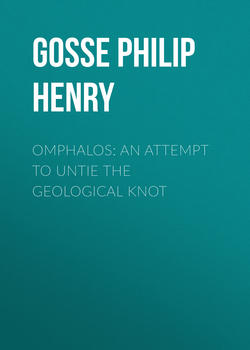Omphalos: An Attempt to Untie the Geological Knot

Реклама. ООО «ЛитРес», ИНН: 7719571260.
Оглавление
Gosse Philip Henry. Omphalos: An Attempt to Untie the Geological Knot
I. THE CAUSE
II. THE WITNESS FOR THE MACRO-CHRONOLOGY
III. THE WITNESS FOR THE MACRO-CHRONOLOGY
IV. THE CROSS-EXAMINATION
V. POSTULATES
VI. LAWS
VII. PARALLELS AND PRECEDENTS
VIII. PARALLELS AND PRECEDENTS
IX. PARALLELS AND PRECEDENTS
X. PARALLELS AND PRECEDENTS
XI. PARALLELS AND PRECEDENTS
XII. THE CONCLUSION
Отрывок из книги
A High Court of Inquiry has been sitting now for a good many years, whose object is to determine a chronological question of much interest. It is no less than the age of the globe on which we live. Counsel have been heard on both sides, and witnesses have been called, and most of the judges have considered that an overwhelming preponderance of testimony is in favour of an immeasurably vast antiquity. A single Witness on the other side, however, has deposed in a contrary sense: and, though he has said but little, some of those who have heard the cause attach such weight to his testimony, that they do not feel satisfied to let it be overborne. Counsel on the former side have, indeed, cross-examined the Witness, and dissected his testimony with much skill, and they contend that what he said has been misunderstood by the minority; and that, as his words may at least bear a sense which would not contradict those of the opposing witness, the clear, copious, and unvarying deposition previously made, ought to command the verdict of the Court.
The minority are silenced, but not satisfied; they know not how to give up the Witness on whose veracity they have been wont to rely; but they are unable to answer the arguments brought against him.
.....
The trees of a temperate climate – the oak, the beech, the maple, the poplar, and the birch – which now attain their highest limit somewhere about 70° of north latitude, and there are dwarfed to minute shrubs, appear then to have grown at the very verge of the polar basin; and that in the condition of vast and luxuriant forests, perhaps occupying sheltered valleys between mountains whose steep sides were covered with snow, already become perennial, and ever and anon rolling down in overwhelming avalanches, such as those which now occasionally descend into the valleys of the Swiss Alps.
The coast of Suffolk displays a formation known as the Crag – a local name for gravel – which rests partly on the chalk; but, as it lies in other parts over the London Clay, it is assigned to the later Tertiary, or what is called the Pleiocene period. It is divided into the coralline and the red crag, the latter being uppermost where they exist together, and therefore being the more recent. The Coralline Crag is nearly composed of corals and shells, the former almost wholly extinct now; but the latter containing upwards of seventy species still existing in the adjacent seas. The Red Crag contains few zoophytes, but is remarkable for the remains of at least five species of Whales. Other Mammalia occur in this formation, among which are the red deer and the wild boar of modern Europe.
.....